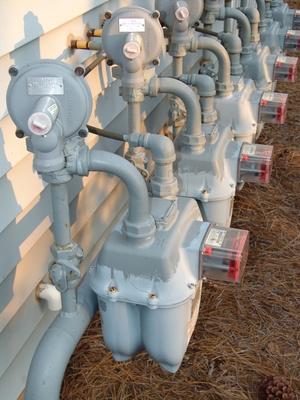
Compressed natural gas is a pressurized form of the same type of natural gas that is used for heating. The natural gas that is used to fuel vehicles is typically pumped to a gas fueling station in an uncompressed state and is then compressed and dried on-site. This is typically accomplished through use of a reciprocating compressor, which uses positive displacement to reduce the volume of gas that is contained in a cylinder.
Obtain a connection to a natural gas pipeline. Natural gas pipeline systems are available in most areas that offer natural gas for heating uses or that use natural gas to fuel electrical plants. You will need to contact your local natural gas company and government authorities for information on obtaining a source of natural gas from their pipelines.
Obtain a reciprocating compressor. A reciprocating compressor is a device that compresses natural gas from the pipeline into a form that is suitable for storage in a compressed natural gas cylinder, and, ultimately, in a vehicle that runs on compressed natural gas. Natural gas that is located in local pipelines is typically pressurized at a rate between one-quarter pound per square inch up to three pounds per square inch; a reciprocating compressor can safely compress natural gas to pressures of up to 3,600 pounds per square inch.
Lubricate your compressor. For optimal performance you should use a high-viscosity, non-detergent lubricant that is specifically designed for use with reciprocating compressors.
Connect your reciprocating compressor to the natural gas pipeline that you have received authorization to use.
Turn on your compressor. The compressor will use a piston to compress the low-pressure natural gas from the pipeline into a highly pressurized form that is suitable for vehicular use.